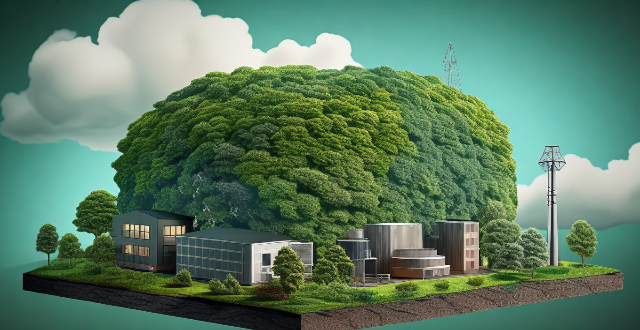Ses Effect

What is the greenhouse effect ?
The greenhouse effect is a natural process that warms the Earth's surface through the trapping of heat by greenhouse gases. These gases include carbon dioxide (CO2), methane (CH4), and nitrous oxide (N2O), which are released by various human activities and natural processes. The greenhouse effect is essential for life on Earth, but human-induced enhancement of this effect has led to global warming and associated environmental issues.

How does the greenhouse effect work ?
The greenhouse effect is a natural process essential for life on Earth, where certain gases trap the sun's energy, warming the planet. Human activities have increased these gases' concentration, leading to an enhanced greenhouse effect and global warming. The process involves sunlight absorption, re-emission as infrared radiation, trapping by greenhouse gases, and planetary warming. Human impact includes increased emissions from burning fossil fuels and deforestation, leading to rising temperatures, extreme weather events, sea level rise, and habitat loss. Urgent action is needed to mitigate these environmental challenges.

What are the causes of the greenhouse effect ?
In this article, we explore the natural and human-intensified causes of the greenhouse effect and its potential consequences. The greenhouse effect is a process where certain atmospheric gases trap heat from the sun, warming the Earth's surface. Human activities such as burning fossil fuels, deforestation, and agricultural practices have increased the levels of these gases, leading to an intensified greenhouse effect and contributing to global warming. The consequences of an intensified greenhouse effect include rising temperatures, melting ice caps and glaciers, extreme weather events, ecosystem disruption, and impacts on human health. To address these challenges, collective action is needed to reduce greenhouse gas emissions and transition to sustainable practices.

Is the greenhouse effect a natural phenomenon or human-induced ?
The greenhouse effect is a natural process that helps maintain Earth's climate, but human activities have significantly increased greenhouse gas concentrations, leading to an enhanced or "human-induced" effect. This has resulted in global warming and other environmental issues, such as rising sea levels, extreme weather events, and ocean acidification.

What role do carbon emissions play in the greenhouse effect ?
The article discusses the role of carbon emissions in the greenhouse effect, which is caused by certain gases trapping heat from the sun in the Earth's atmosphere. Carbon dioxide (CO2) is one of several greenhouse gases that contribute to this process. Human activities such as burning fossil fuels for energy production and deforestation are major sources of carbon emissions, leading to an enhanced greenhouse effect and global warming. This has resulted in a range of impacts on the Earth's climate system, including rising sea levels, more frequent and intense heatwaves, changes in precipitation patterns, and shifts in ecosystems and wildlife populations. To mitigate these effects, strategies such as transitioning to renewable energy sources and improving energy efficiency are being implemented or proposed. International agreements like the Paris Agreement aim to reduce carbon emissions and limit global temperature rise.

How does the greenhouse effect impact ocean levels ?
The greenhouse effect, essential for Earth's habitThe greenhouse effect, essential for Earth's habittensified by human activities like has been intensified by human activities like burning fossil fuels and deforestation. This amplified effect is causing global warming, which leads to rising ocean levels through melting polar ice caps and thermal expansion of seawater. Changes in precipitation patterns also indirectly affect ocean levels by redistributing water. Addressing the causes of the enhanced greenhouse effect is vital to mitigate these impacts and protect the planet's future.

How does the greenhouse effect affect weather patterns ?
The greenhouse effect is a natural process that maintains Earth's warm temperatures, making life possible. However, human activities like burning fossil fuels and deforestation have increased the concentration of greenhouse gases, leading to global warming. This enhanced greenhouse effect affects weather patterns by causing higher global temperatures, changes in precipitation patterns, extreme weather events, disruption of seasonal patterns, and changes in ocean currents. Addressing this issue requires reducing greenhouse gas emissions and adapting to the changing climate.

How does deforestation contribute to the greenhouse effect ?
Deforestation contributes to the greenhouse effect by releasing large amounts of carbon dioxide, reducing oxygen levels and disrupting ecosystems.

What are the consequences of the greenhouse effect ?
The enhanced greenhouse effect, caused by human activities, has led to rising global temperatures, changes in precipitation patterns, ocean acidification, impacts on biodiversity, health implications, and economic impacts. These consequences affect various aspects of life on Earth and require action to reduce greenhouse gas emissions and mitigate the effects of climate change.

How has the greenhouse effect affected the climate over time ?
The greenhouse effect is a natural process that warms the Earth's surface by trapping heat from the Sun. However, human activities have increased the concentration of greenhouse gases in the atmosphere, leading to an enhanced greenhouse effect and global warming. This has resulted in rising global temperatures, melting ice caps and glaciers, more frequent and severe extreme weather events, changes in ecosystems and biodiversity, and ocean acidification. To mitigate these effects, it is crucial to reduce our reliance on fossil fuels, promote renewable energy sources, protect forests and other natural habitats, and adopt sustainable practices in agriculture and industry.

What is the difference between global warming and the greenhouse effect ?
Global warming and the greenhouse effect are two interconnected phenomena that have a significant impact on Earth's climate. The greenhouse effect is a natural process where certain gases in the atmosphere trap heat from the sun, helping to maintain a stable climate on Earth. On the other hand, global warming is an ongoing phenomenon caused primarily by human activities such as burning fossil fuels and deforestation. While both involve greenhouse gases and their impact on Earth's climate, there are key differences between them, including their cause, duration, impact, and potential solutions.

What are some examples of gases that contribute to the greenhouse effect ?
The greenhouse effect is a natural process that warms the Earth's surface. Human activities have increased the concentration of certain gases in the atmosphere, leading to an enhanced greenhouse effect and global warming. Major greenhouse gases include carbon dioxide (CO2), methane (CH4), nitrous oxide (N2O), fluorinated gases, ozone, and water vapor. These gases trap heat in the Earth's atmosphere and contribute to global warming. Reducing emissions of these gases is essential to mitigate climate change and its impacts on ecosystems, societies, and economies worldwide.

How do spaced repetition systems align with scientific memory principles ?
Spaced repetition systems (SRS) align with scientific memory principles in several ways, including active recall, the spacing effect, the testing effect, retrieval cue variability, elaborative interference, desirable difficulty, feedback, and individualized learning. These techniques help to enhance information retention and optimize the learning process.

Can the greenhouse effect be reversed ?
The greenhouse effect is essential for life on Earth, but human activities have increased its intensity, leading to global warming. Strategies to reverse this enhanced effect include reducing emissions through renewable energy and energy efficiency, reforestation, carbon capture and storage, and negative emissions technologies like direct air capture. However, challenges such as technical feasibility, political will, economic impact, and environmental trade-offs must be considered. While a complete reversal may not be fully achievable in the short term, significant progress can be made with concerted global efforts.

How can we reduce the greenhouse effect ?
This text provides a comprehensive summary of strategies to reduce the greenhouse effect, including reducing fossil fuel use, promoting renewable energy sources, improving energy efficiency, protecting and planting trees, reducing methane and nitrous oxide emissions, developing and implementing climate policies, and promoting awareness and education. It emphasizes that collective efforts are needed to mitigate the impacts of climate change.

How do greenhouse gas emissions affect climate change ?
Greenhouse gas emissions, including carbon dioxide (Greenhouse gas emissions, including carbon dioxide (e (CH4), trap heat in the Earth's atmosphere, leading to an increase in global temperatures. This process is known as the greenhouse effect. Human activities have increased the concentration of these gases, enhancing the greenhouse effect and causing global warming. The enhanced greenhouse effect leads to various effects such as global warming, ocean acidification, impact on ecosystems, and human health and well-being. To mitigate these effects, it is essential to reduce our carbon footprint by adopting sustainable practices such as using renewable energy sources, improving energy efficiency, protecting natural habitats, promoting sustainable agriculture practices, and encouraging eco-friendly habits.

What is the relationship between the greenhouse effect and ice caps melting ?
The greenhouse effect, amplified by human activities, leads to global warming which causes ice caps to melt, leading to sea level rise, climate change, and ecosystem disruption.

How long will it take for carbon sequestration to have a noticeable effect on atmospheric CO2 levels ?
Carbon sequestration is a process that aims to reduce atmospheric CO2 levels by capturing and storing carbon dioxide. The effectiveness of this process depends on various factors such as the rate of carbon sequestration, global emissions reduction efforts, and the health of natural carbon sinks. In the short term, it is unlikely that carbon sequestration alone will have a noticeable effect on atmospheric CO2 levels. However, in the medium to long term, if significant investments are made in scaling up carbon sequestration technologies and reducing global CO2 emissions, some noticeable effects may begin to emerge. These could include slower rates of CO2 accumulation, improved air quality, reduced global warming, and restoration of natural ecosystems. Therefore, sustained investments in carbon sequestration and other climate mitigation strategies can help achieve long-term reductions in atmospheric CO2 levels and mitigate the effects of climate change.

How do greenhouse gases contribute to climate change ?
This text explains the role of greenhouse gases in climate change and how human activities contribute to excessive levels of these gases. It outlines various sources of greenhouse gases such as fossil fuel combustion, deforestation, agriculture, industrial processes, and waste management. The impacts of increased greenhouse gases on the environment are discussed, including global warming, sea level rise, extreme weather events, ocean acidification, and biodiversity loss. Finally, the text suggests strategies for mitigating greenhouse gas emissions, such as reducing fossil fuel use, enhancing energy efficiency, promoting renewable fuels, reforestation, sustainable agriculture practices, carbon capture, and policy initiatives.

What role does music play in team sports and group fitness classes ?
Music plays a crucial role in team sports and group fitness classes by motivating participants, setting the pace, enhancing enjoyment, fostering social interaction, improving mental toughness, and aiding recovery. It is used across various settings like yoga, cycling, basketball, and team-building activities to create a specific atmosphere or achieve a desired effect.

What is the role of financial advisors in developing an investment strategy ?
Financial advisors are pivotal in shaping investment strategies by identifying financial goals, assessing risk tolerance, analyzing market conditions, designing portfolio allocation, monitoring and adjusting investments, and providing ongoing advice. They help individuals and businesses achieve their short-term objectives like building an emergency fund and reducing debt, as well as long-term goals such as retirement planning and education funding. By evaluating risk appetite, they tailor investment plans that prioritize capital preservation or pursue growth potential through diversification. Understanding macroeconomic factors and industry trends further informs investment decisions. In portfolio design, they allocate assets across classes and employ diversification to mitigate risks. Through performance tracking and rebalancing, they ensure investments remain aligned with goals. Moreover, financial advisors offer educational and emotional support, enhancing client knowledge and helping them manage risks. Overall, they ensure strategies reflect clients' evolving needs, fostering informed and balanced investment approaches.

What are the key economic indicators to watch for global growth ?
Monitoring key economic indicators such as GDP, inflation rate, unemployment rate, interest rates, trade balance, current account balance, manufacturing and service sector indexes, stock market performance, and consumer confidence indices is crucial for policymakers, investors, and businesses to understand global economic growth. These indicators provide insights into the overall health of an economy, guide decision-making processes, and help predict future trends.

What are the key principles of ecological design in urban planning ?
Ecological design is a crucial aspect of urban planning that focuses on creating sustainable and environmentally friendly cities. It aims to integrate natural systems with human-made structures, reducing the negative impact on the environment while promoting biodiversity and enhancing the quality of life for residents. Key principles include preserving natural habitats, creating new ones, connecting them; reducing energy consumption through renewable sources; managing water efficiently; promoting non-motorized transport and reducing car dependency; supporting local food production; building resilient infrastructure; involving community in decision-making processes; promoting environmental education; and respecting cultural heritage.